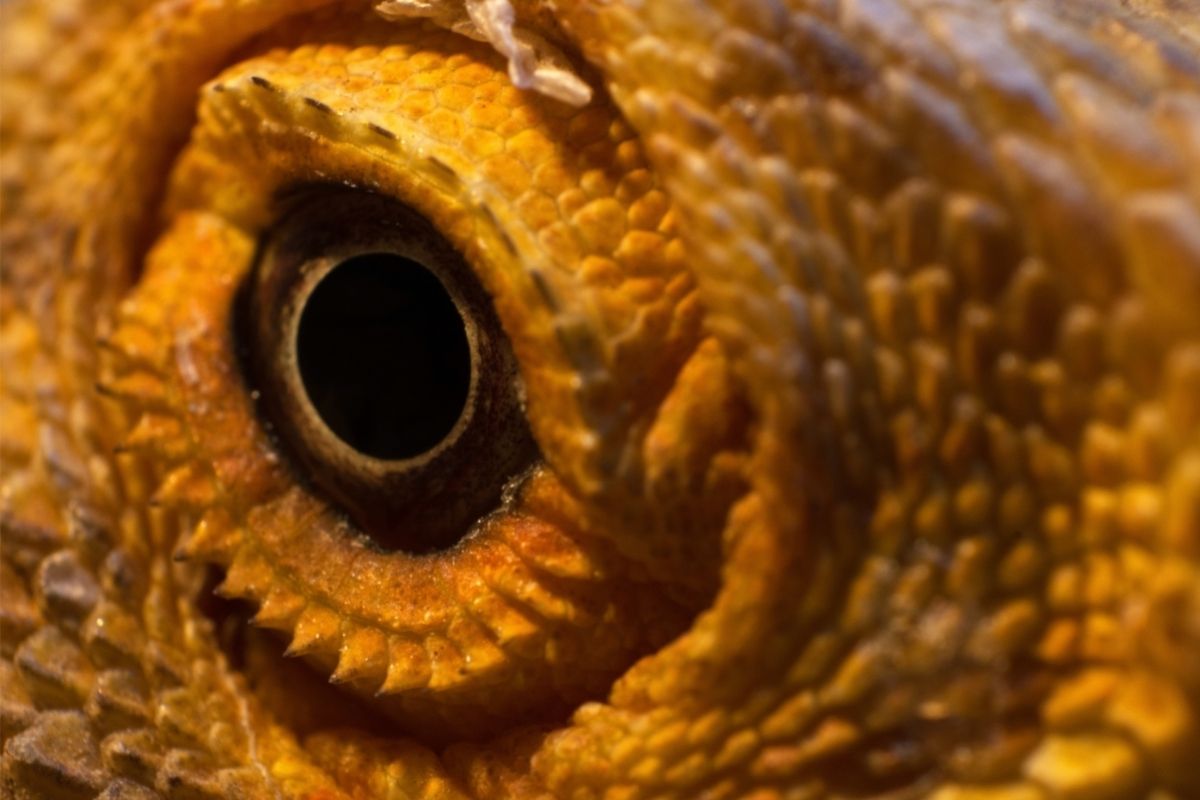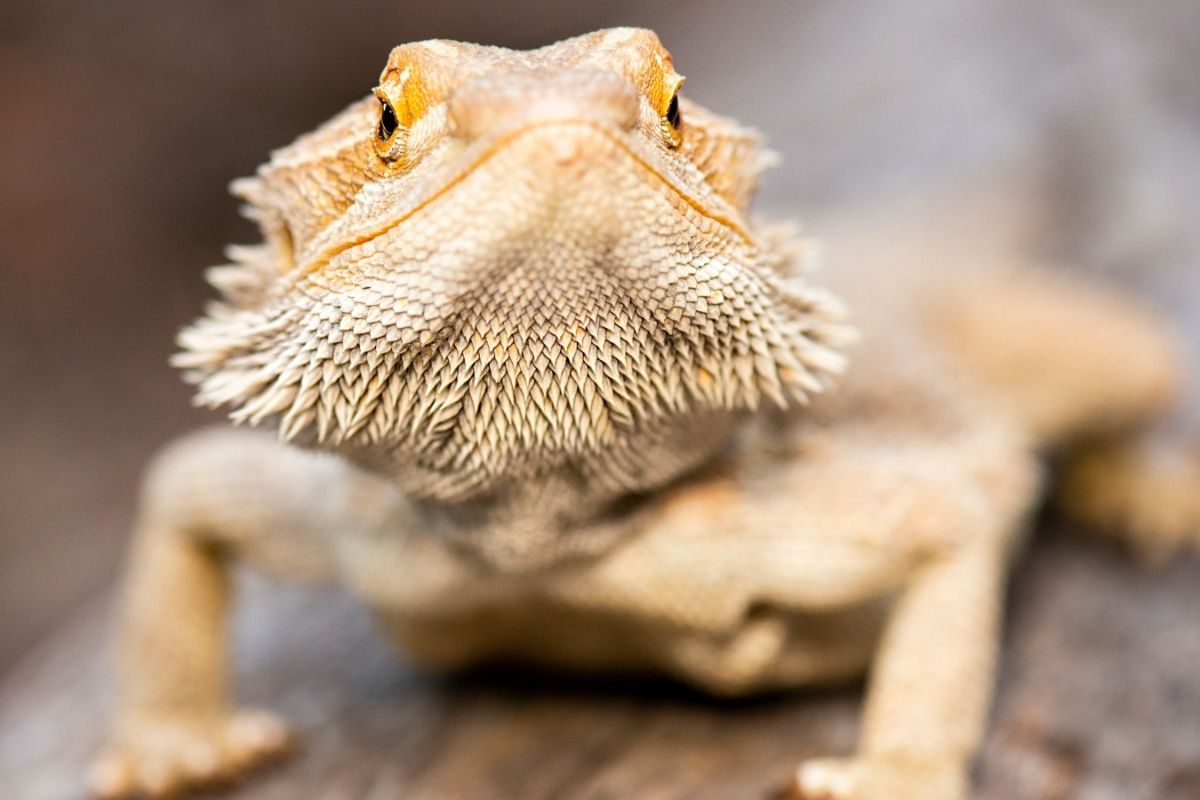Have you ever wondered if a bearded dragon would make a great pet?
Well, the answer is a resounding yes!
They are fascinating creatures and a joy to be around, and you may have heard that they have fantastic eyesight. Is this true?

Yes, bearded dragons have great vision.
They can see in the dark, and they can see objects from afar.
Their eyesight is much better than our eyes and is also used to detect movement.
When a bearded dragon tilts its head, it is trying to get a better view of something.
The third eye is an opening located behind the lizard’s eyes, and it helps them see in dim light.
Bearded dragons have two eyes located at the sides of their head.
Their eyes give them a wide-angle view of their surroundings.
Humans’ eyes are usually located at the front of the head, so the side-eyes of the dragon give them a unique perspective.
The third eye isn’t visible most of the time, but this hidden eye helps them see better than other reptiles.
Bearded dragons have clear, bright, alert eyes.
Their eyes do shed occasionally, but this doesn’t cause them to lose their vision.
Bearded dragons can once again use their wide range of vision to see what is in front and behind them at the exact same time without moving their necks.
The third eye allows them to see things that others cannot.
This gives them a distinct advantage when hunting prey.
The Third Eye
As mentioned already, the third eye is a hidden eye and is quite difficult to find and identify.
This eye doesn’t allow the bearded dragon to see colors or images, and shadows appear when you look into it.
However, they can use their third eye to gather information and make sense of the world around them.
Bearded Dragons’ eyes are very sensitive to light.
When you close your eyes and move your hand up to your eye, everything gets darker; this is what the third eye feels like to a bearded dragon because the third eye is covered by a layer of skin/scales.
Color
Bearded dragons can see more colors than humans because they have 4 color receptors instead of 3.
They can see UV waves.
This is extremely important when caring for them, as you should always make sure you have the right UV lights.
Bearded dragons can see reds, greens, blues, and purples.
Not only can beardies see lots of colors, they can also change their own color too.
Their skin is very colorful, and they can change colors depending on what they’re doing.
They might change color when they feel threatened by something.
If you notice this, then you know that your bearded dragon is reacting to something.
Studies have found a link between the variety of colors a beardie can display and the colors in their natural environment.
For instance, mildurans can blend with sands that are yellow and predominant in the region, while other dragons are better at blending in with their own native sand.
Whether it’s a toy, food or a shirt, or anything else, an object may create a response in your beardie, based entirely on a genetic predisposition towards that particular color.
Darkness
Bearded dragons can’t see in the dark.
Their pupils are lazy, but they’re still able to see in low light.
Their eyes are quite sensitive to light changes.
When the lights are turned on and off at night, the bearded dragons’ eyes get irritated, and they may wander about looking for a safe place to rest.
Many people even use multiple time switches off one light after the other to make it easier for them to know when it is bedtime so they don’t get confused.
Distance
There is no clear answer to whether or not bearded dragons can see into the distance.
However, they can see as far as you can possibly see.
If you put your lizard on one side of the cage and show him a super worm, he’ll see it.
Protection

Bearded dragons have a wide range of vision.
They can see things close to them and things far away.
Their eyesight is very useful because they can detect danger from far away.
But they also need to know how to escape danger.
Their unique eyes help them do this.
When they feel danger, they can sense it using their parietal eye or third eye, as we discussed earlier.
A dragon’s third eye is very sensitive and can sense when there is an intruder nearby.
This helps dragons to avoid being attacked by other predators.
The fact that bearded dragons’ eyes are placed very close together makes it easy for them to see things from many different angles.
This allows them to easily spot bugs hiding in rocks or other places.
In captivity, bearded dragons are kept in large tanks with lots of rocks and plants.
This helps to attract insects to be caught by the dragon’s keen eyesight.
Time Of Day
Parietal eyes help dragons know what time it is at night.
They are important because they allow dragons to understand the day-night cycle.
Lights shouldn’t be left on in the tank during nighttime hours.
This will cause confusion for your bearded dragon.
Their eyesight won’t work properly because they’ll think it’s daytime.
Finding Home
Bearded dragons use their eyes to navigate and find their way back home.
Their eyes help them see better than most other animals.
Bearded dragons cover their eyes when they go out of their territory.
Dragons with parietal eyesight are more likely to be able to navigate and orient themselves than other reptiles.
A useful advantage in the wild.
Other Unique Characteristics
Bearded dragons change the color of their bodies for various reasons such as temperature changes, camouflage, social interactions, and to ward off rivals or predators.
Bearded dragons’ color is usually tan or black.
When they interact with others, they’ll change the color of their back.
Their backs turn yellow when they’re warm and dark brown or black when they’re cold.
Chest and beards don’t change color when regulating temperature but instead become jet black and cream when communicating with other dragons.
Interestingly they also do a type of push-up and head bob.
To show anger or excitement, the bearded dragons will darken up.
Researchers also show that showing a dark chest/neck displays qualities that will entice a prospective mate.
They may turn orange with a black beard, and chase off rivals from their territory.
It is thought that a beardie sees himself as having many different colors.
He knows he has green eyes, blue hair, yellow skin, black scales, and red spots.
He also knows that he has a long snout, short legs, and a tail.
Bearded dragons certainly are very friendly and easy to care for.
Their diet consists of insects and worms.
They make great pets if you want a reptile that is not poisonous or venomous.
However, they do need to be kept away from cats and dogs, and to protect your bearded dragon; you should give them hiding places where they can be safe.
Bearded dragons love being around people!
They’re very social creatures who enjoy playing with each other and interacting with humans.
They are also super easy to train.
Their favorite foods include vegetables and fruits.
They are very active reptiles and even enjoy playing games.
Their eyes stay closed when they show trust in someone.
When they do come close to someone, they lick them.
A bearded dragon who comes to you will also relax its body muscles.
Conclusion
So, there you have it. Now you know exactly how bearded dragons see and that they make great pets, what’s stopping you?
Time to let a cute beardie join the family.
